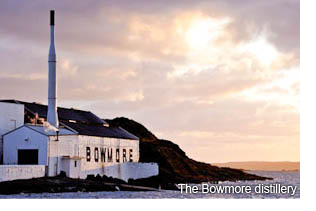Thomson's whisky Q&A
With Burns Night on Sunday, our resident Scot answers a few of the most typical whisky questions
Whisky or whiskey?
Whisky means Scotch; with an 'e', whiskey means Irish or American.
What is whisky actually made of?
In Scotland, the best whisky is made of malt, which is barley seed that has been allowed to germinate before being dried and ground. The malt is soaked, and its sugars extracted; these sugars are then fermented, and the resulting liquid (effectively beer, but called the wash) distilled. Finally, the distilled spirit must be matured in casks for a legal minimum of three years before it can be called whisky, although the best whiskies will be matured for much longer. Other cereals, such as corn, rye and wheat can also be mixed with malt in blended whisky, which will be cheaper than pure malt. Our Bank Note is a brilliant example of a sweet, smooth, economical blended whisky with a high proportion of malt. In the US, bourbon is a whiskey made from corn, and it tends to have a more caramel and vanilla character than Scotch. Rye whiskey is mostly associated with North America, especially Canada, and is almost always made from a blend of rye and either corn or barley.
What's a single malt?
So there are blended whiskies (mixing malt and grain) and then blended malts, which are also called 'pure malts'; these are whiskies made only from malt, but mixing the produce of different distilleries. Then you have single malts, which are the produce of only one distillery, resulting in something more individual. For instance, Stronachie is a distinctive 19th century-style single malt produced at Benrinnes distillery. And at the top of the tree, a step up from single malts, there are single cask whiskies - one single barrel from one distillery, bottled into perhaps 300 bottles. Only the very best whiskies are bottled this way. At Uncorked, most of the whiskies we sell are single cask.
What does it mean when you say a whisky is 'peated' or 'peaty'?
In the Western Isles, and most especially on the island of Islay (pronounced 'eye-la'), peat is used to power the kilns that dry the germinating barley seed from which whisky will be distilled. The peat imparts a powerful smoky flavour to the malt.
Should I buy peated or unpeated malts?
It's a stylistic decision. Some whiskies such as Highland Park have a light but distinct thread of peat running through them. While some drinkers adore the heavily peated style of Bowmore, others much prefer to avoid peated malts altogether in favour of the bright, sweet, fruit-driven flavours of Speyside and Highland whiskies. The Islay whisky Bunnahabhain is often referred to as the 'imposter' because although it comes from Islay, it is not peat-driven - add a splash of water to it and an array of sweet flavours come to the fore. Which brings me to my last question:
Neat, on the rocks, or a splash of water?
Ice damps down flavours, so unless you're somewhere very hot or drinking something very rough, I wouldn't recommend it. All whiskies benefit from, nay demand, a splash of water, as it releases aromas; cask strength malts, which are typically released at between 50-60%, demand some more. Add it little by little and glory in the changing aromas.
And if reading this has made you thirsty for a wee dram of the water of life, then the Bank Note is on tasting today from 12:00 - 6:30pm in our Bishopsgate shop along with some fine Burgundies. /NT
| Vintage | Description | Cs Sz | Bt Sz | Cs | Bts | Cs ib | Cs inc | Bt inc | ||
|---|---|---|---|---|---|---|---|---|---|---|
| N.V. | Stronachie 10 yo 43% (Highlands) | 6x | 70cl | 0 | 5 | - | £215.80 | £39.50 | Buy | |
| N.V. | Stronachie 18 yo 46% (Highlands) | 6x | 70cl | 0 | 0 | Buy | ||||
| N.V. | AD Rattray Bank Note 43% | 12x | 70cl | 1 | 5 | - | £274.99 | £25.00 | Buy | |
| 1991 | Aultmore, AD Rattray 22 yo 57.5% | 6x | 70cl | 0 | 0 | Buy | ||||
| 1983 | Balmenach, AD Rattray 30 yo 51.2% | 6x | 70cl | 0 | 0 | Buy | ||||
| 1996 | Dailuaine, AD Rattray 17 yo 56.9% | 6x | 70cl | 0 | 0 | Buy | ||||
| 1996 | Glentauchers, AD Rattray 17 yo 54.5% | 6x | 70cl | 0 | 0 | Buy | ||||
| 1995 | Miltonduff, AD Rattray 18 yo 58.5% | 6x | 70cl | 0 | 0 | Buy | ||||
| 1991 | Auchroisk, AD Rattray 23 yo 56.5% | 6x | 70cl | 0 | 0 | Buy | ||||
| 1990 | Bunnahabhain, AD Rattray 23 yo 56.8% | 6x | 70cl | 0 | 0 | Buy | ||||
| 1989 | Bunnahabhain, AD Rattray 24 yo 45.3% | 6x | 70cl | 0 | 0 | Buy | ||||
| N.V. | AD Rattray Cask Islay 46% | 6x | 70cl | 2 | 3 | - | £215.96 | £39.50 | Buy | |
| 1999 | Bowmore, AD Rattray 14 yo 58.8% (Islay) | 6x | 70cl | 0 | 0 | Buy | ||||
| 2004 | Evan Williams Single Barrel Bourbon | 6x | 70cl | 0 | 0 | Buy | ||||
| 1992 | Longmorn, AD Rattray 21 yo 48.0% | 6x | 70cl | 0 | 0 | Buy | ||||
| 1990 | Highland Park, AD Rattray 23 yo 56.2% | 6x | 70cl | 0 | 0 | Buy |
